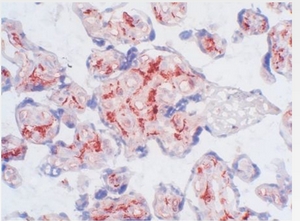CD163 Mouse Monoclonal Antibody [Clone ID: 5C6-FAT]
Specifications
| Product Data | |
| Clone Name | 5C6-FAT |
| Applications | FC, IHC, WB |
| Recommended Dilution | Immunohistochemistry on Frozen Sections: 0.5 μg/ml (1/400). Immunohistochemistry on Paraffin Sections: 1 μg/ml. Proteinase K pretreatment for antigen retrieval is recommended. Suggested Positive Control: Human placenta. Has been described to work in FACS and Western blots. |
| Reactivities | Human |
| Host | Mouse |
| Isotype | IgG1 |
| Clonality | Monoclonal |
| Immunogen | Human CD163. The epitope has not been further characterized. |
| Specificity | Clone 5C6 FAT recognizes CD163, a membrane glycoprotein on human monocytes and macrophages which is expressed in intermediate and late inflammatory stages. Antigen distribution on isolated cells: Monocytes, particularly after dexamethasone treatment or after 2-5 days in culture. Does not react with lymphocytes, granulocytes or platelets. Antigen Distribution Tissue Sections: Positive staining can be observed in the skin (histiocytes), gut, Kupffer cells, few alveolar macrophages, a major population of macrophages in the placenta, varying degrees of macrophages in inflamed tissues, including tumorous tissue depending on the inflammatory stage. Red pulp, but not white pulp macrophages of the spleen, andcortical macrophages of the thymus are detected. Macrophages in the synovialis of patients with rheumatoid arthritis. In alveolar macrophages and in Kupffer cells a double staining can be observed with monoclonal antibody BM4022 (clone 25F9) which is not the case in other tissues. Isolated Cells: Monocytes, particularly after dexamethasone treatment or after 2-5 days in culture. Does not react with lymphocytes, granulocytes or platelets. |
| Formulation | Stock Solution containing PBS, pH 7.2 with 5 mg/ml BSA as a stabilizer and 0.09% Sodium Azide as a preservative Label: Biotin State: Lyophilized purified IgG fraction |
| Reconstitution Method | Restore with 0.5 ml distilled water. |
| Concentration | 0.2 mg/ml (after reconstitution) |
| Purification | Affinity Chromatography |
| Conjugation | Biotin |
| Storage | Prior to reconstitution store at 2-8°C. |
| Stability | Shelf life: one year from despatch. |
| Database Link | |
| Background | CD163 is a scavenger receptor for the haemoglobin-haptoglobin complex, and is upregulated by glucocorticoids and IL-10. The extracellular portion of the receptor is regularly shed and can be found in the circulation. An important function of CD163 seems to be in the adhesion of monocytes to activated endothelial cells. CD163-positive cells include skin histiocytes, Kupffer cells, spleen macrophages of the red pulp, and some thymus macrophages. The antigen is also found abundantly in human term placenta, and regularly in acute and chronic inflammatory lesions. |
| Synonyms | M130, Hemoglobin scavenger receptor, Macrophage marker |
| Reference Data | |
Documents
| Product Manuals |
| FAQs |
{0} Product Review(s)
0 Product Review(s)
Submit review
Be the first one to submit a review
Product Citations
*Delivery time may vary from web posted schedule. Occasional delays may occur due to unforeseen
complexities in the preparation of your product. International customers may expect an additional 1-2 weeks
in shipping.






























































































































































































































































 Germany
Germany
 Japan
Japan
 United Kingdom
United Kingdom
 China
China



